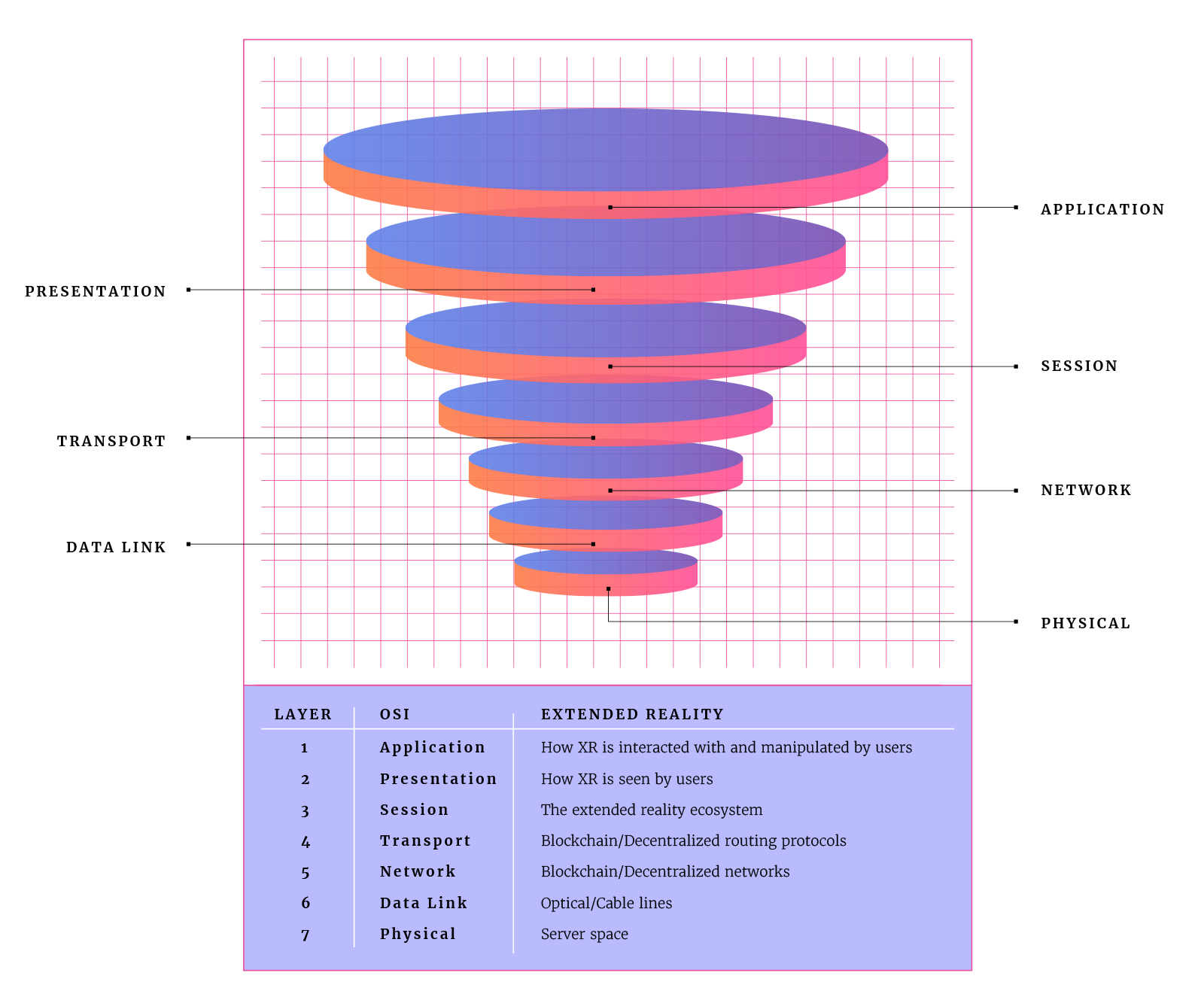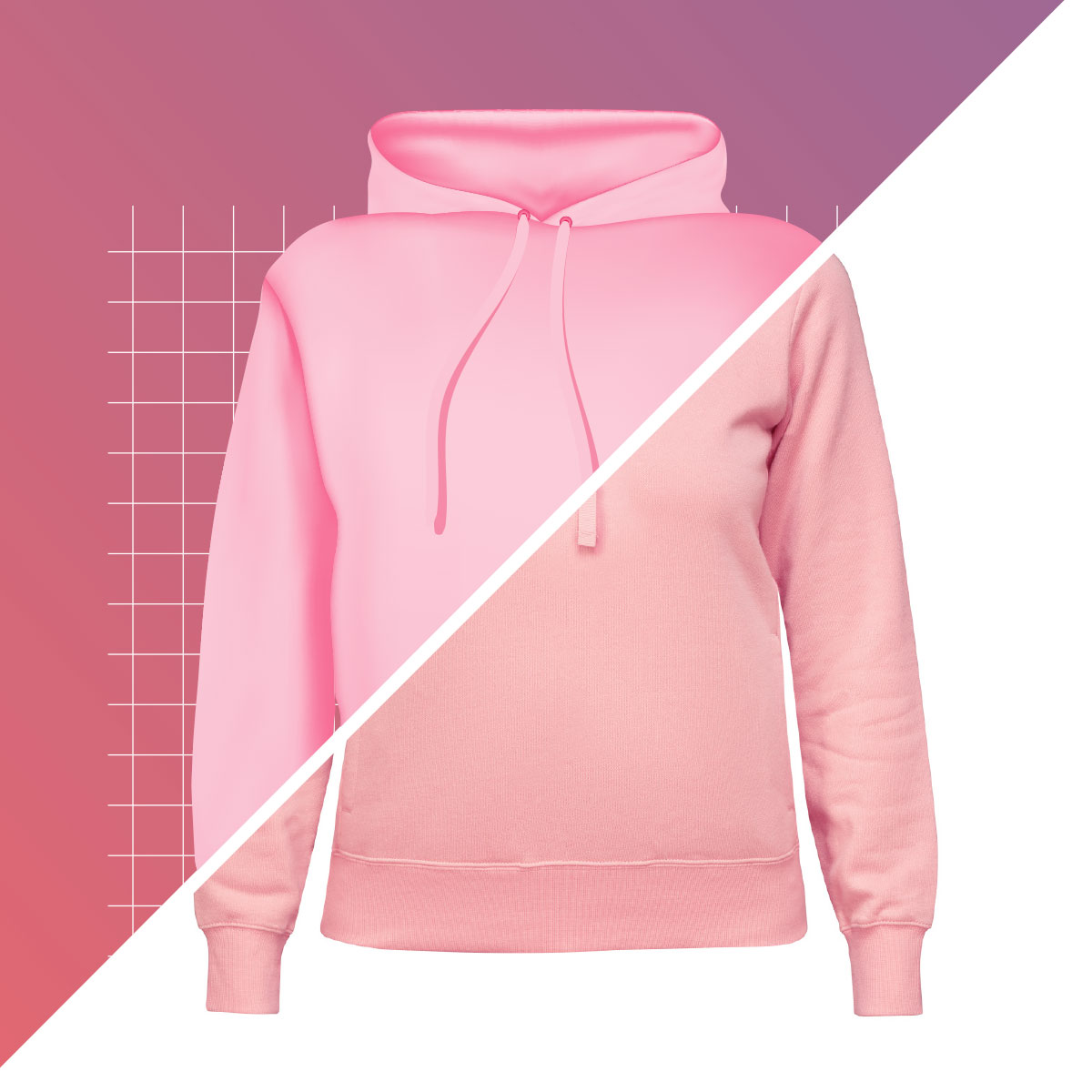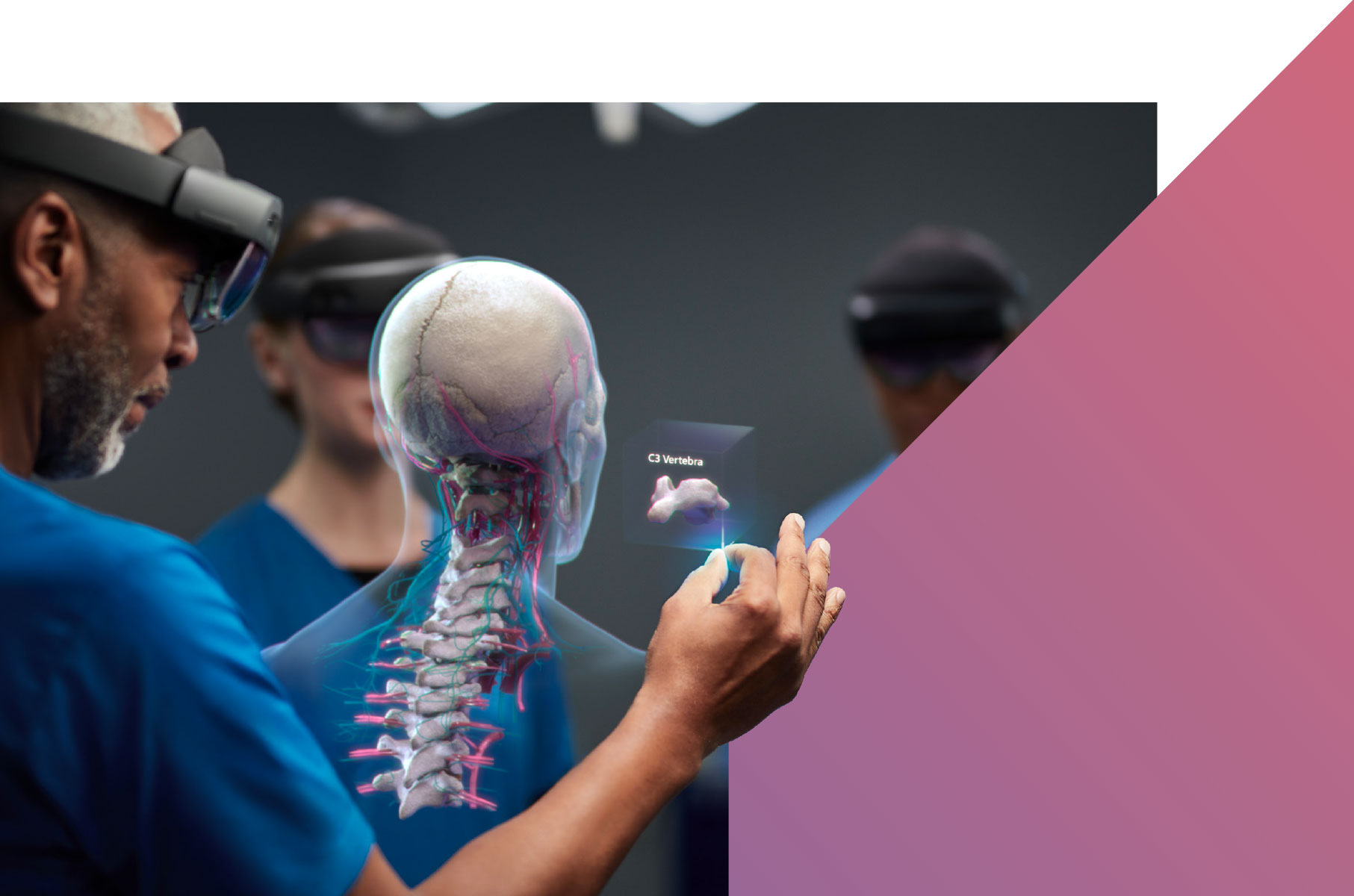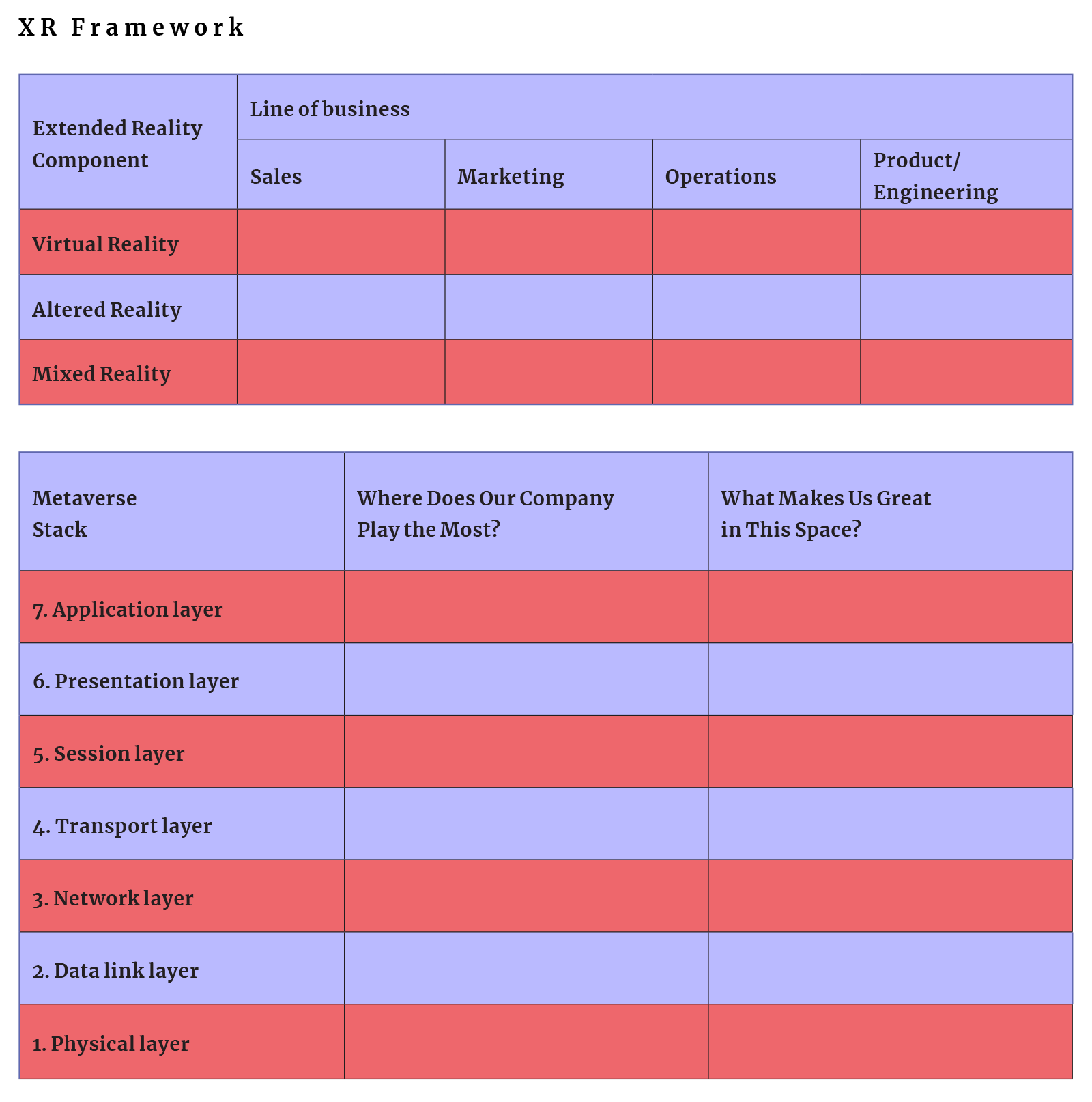e’ve warned before that it is time to digitally self-disrupt (The Jabian Journal Fall 2019, “It’s Officially Time to Self-Disrupt”); now, another digital external disruption is here, and those who choose to catch the tide will ride to new heights. Those who don’t adapt to the Metaverse will miss out on this growing phenomenon and potentially see their markets and their customers disrupted.
In this article, we’re going to take you on a guided journey down the Metaverse rabbit hole. We’ll show you what the Extended Reality matrix actually is, what it is composed of, and how your company can benefit from getting involved. Once we are grounded on the basics, we’ll discuss the difference between knowing the path and walking the path. Finally, we are going to arm you with a five-step process to help you determine how your business can enter and use the Metaverse to your advantage.
SO WHAT IS THE METAVERSE, AND HOW IS IT GOING TO AFFECT YOUR COMPANY?
The Metaverse has been defined as a deeply immersive experience of 3-D worlds that are persistent, synchronous, and interoperable.
Persistent: Continuously operational
Synchronous: Updating in real time
Interoperable: Actively working together across multiple mediums
Current virtual worlds include gaming platforms like Roblox and Fortnite, as well as decentralized communities like Decentraland and Pavia. Outside of these edge cases, there are communities, groups, and organizations bound by common thoughts, principles, beliefs, goals, and hardware, such as Horizon Worlds and Second Life.
The commonality among all these groups is the replication of real-life experiences in a virtual environment. There is the added benefit that people creating the Metaverse are no longer bound by real-world physics and limitations, allowing complete creativity.
THE REALITY (VIRTUALITY) IS THAT THE METAVERSE IS NOT JUST THE METAVERSE.
While the presentation layer of this new digital stack is regarded more broadly as the Metaverse, there is a whole new internet’s worth of underlying systems that interconnect and enable these experiences across digital universes. When thinking back to the fact that all this information must be stored, processed, transferred, and translated for user consumption, we can leverage the Open Systems Interconnection (OSI) model1 to more clearly see and comprehend what is going on in the Metaverse.
At the lowest level of this model lie the physical, data link, and networking layers. These are the core components that enable the Metaverse to begin to exist. These are the server rack space, connection points, and interactions between systems that create the Metaverse. Without these layers firmly constructed as the foundation, there is no opportunity for these individual realities to be built and to interact with one another.
From there, we move up to the transportation, session, presentation, and application layers of the model. These are the layers that give the standard user access, opportunity, and control to manipulate, build, and interact with the data to create the Metaverse that others get to enjoy. These underlying systems make up what we have come to know as Virtual Reality (VR), Augmented Reality (AR), and Mixed Reality (MR), creating the totality of what is becoming known as Extended Reality (XR).

HOW CAN YOU PLAY?
In order to understand where your company might be able to best play, we must first define those components that make up this multidimensional mediated reality. Starting with the concept that most people are familiar with and has been receiving the greatest press attention, VR.
Virtual reality is a computer-generated simulation that blocks out reality and replaces it entirely with a simulated experience. This is exemplified by gaming sets such as the Oculus and other VR headset systems. If we think about reality and virtuality as a sliding scale, then VR is at the furthest point away from reality, into full simulation.
Pulling back on the simulation throttle, we enter AR. AR injects computer-generated content into the real world that we access through some form of interface. A great example here is the filters built into Snapchat and the mobile-based game Pokémon Go.
Mixed (or mediated) reality is that sliding scale between full simulation and pure reality. It is the incorporation of simulated experiences in normal life, like holographic and interactive advertising on the street all the way up to the point of entering true VR.
When you take all these different altered experiences that are modified by technology in some way, shape, or form, we are interacting with extended reality. This runs the span of entirely embedded, new universes in the depths of virtual reality to you running on the street with your headphones and blocking out external auditory stimulation of your surroundings and even to the automated scent machines we find in public bathrooms, shaping and forming our opinion of and interaction with the real world.
We are now seeing the war for the most mover advantage in the Metaverse. Companies like Meta (Facebook), Nvidia, and Microsoft are all competing to try to be the foundational layer of the Metaverse. The fight will determine who will provide the primary set of servers and languages that the rest of the Metaverse builds on. This is especially true in the VR space, which will require massive amounts of computational power to present wholly immersive worlds to garner mass adoption.

Hosted on Decentraland, the Metaverse Fashion Week featured 50-plus luxury brands that sold both digital and physical items.
HOW CAN I USE XR WITH MY BUSINESS?
What have other businesses done, and how do I leverage their lessons to benefit my company? Due to the COVID-19 pandemic, some industries were forced to self-disrupt and adapt to the changing environment faster than anyone could have predicted. Some of these companies have leveraged this opportunity to create new and unique experiences to attract and retain customers.
The simple reality is, if you don’t disrupt your ecosystem and leverage these capabilities, your competition will. Some technology and applications are not yet ready for mainstream adoption, but we are at the point in the technology development cycle where we just need the idea that will ignite the conversation of how to start developing these capabilities.
The retail industry has been a front-runner in the Metaverse space, trying to innovate and cater experiences to their consumer demographics and bring greater brand awareness and encourage new sales channels. This includes everything from virtual events and virtual spaces to combining sales through digital currency mechanisms. Some major retail brands now sell virtual products that, in some cases, can be used to collect real physical items. This assists brands in enhancing their direct-to-consumer (D2C) optionality and cuts down on overhead and transaction costs.
A notable example of this is the Metaverse Fashion Week (MVFW) hosted on Decentraland, which happened in March of 2022. This was a great match for an industry that is no stranger to pop-up stores, provides consumers with unique experiences, and offers one-of-a-kind products. The MVFW featured 50-plus luxury brands that sold both digital and physical items via Non-Fungible Tokens (NFT). There were vendors such as Estée Lauder that made a wearable NFT that you could use with your avatar to promote their Night Repair Serum. The NFT gave your avatar a sparkling aura that was activated by a giant dropper within their virtual space.
French e-commerce accessories platform Monnier Paris (previously Monnier Frères) also had a store in the MVFW that sold wearable NFTs for your avatar. The unique experience here was the fact that you could buy the NFT only with cryptocurrency as well as collect a live version of an exclusive Coach Tabby Pillow bag by Republiqe in a physical store.
Fast food chains are also getting into the mix with XR experiences. Wendy’s built a VR space on Meta’s platform Horizon Worlds. Even though you are not able to buy physical or digital products, they have built a world that they plan to update regularly and see how their audience engages with their brand. Chipotle has also built a world in Roblox where you can master your burrito-rolling skills and win some coupons for your next meal.
Another industry that has really been an early adopter, and some would say the biggest pusher in this space, is the entertainment industry. Gaming has been a leader in applications, with Global VR video gaming revenue reaching $22.9 billion in 2020. Another popular game that was one of the first AR games to hit the market was the Pokémon Go App, released in 2016. In 2020, Pokémon Go hit $1 billion, as its lifetime revenue up to then surpassed $4 billion.
When the pandemic began, a lot of concerts were canceled, which caused artists to look for other ways to perform and connect with their fanbase. As an example, to the cross-boundary capabilities of XR, in 2020 Travis Scott performed an immersive VR concert for over 12.3 million fans in the virtual gaming platform Fortnite.” Technology has caught up to give the performers the ability to still perform in their virtual shows as they would in person, using sensors that make their avatars do the moves they are doing in real life.

Credit: Epic Games
Education can sometimes be more engaging with new technologies. With XR experiences, this brings on another meaning. Think about your first time hearing the “I Have a Dream” speech by Dr. Martin Luther King Jr. The speech itself is moving, and the video and audio that were taken on that day help emphasize the meaning behind his message. That sometimes can get lost in a textbook or a documentary series. In 2020, Time recreated that event and built a VR experience that put you into an immersive experience where you can walk in the footsteps of the people who were there. It debuted an exhibit at the DuSable Museum of African American History in Chicago in February of 2020.3 Now imagine schools being able to use that technology to showcase important historical events that sometimes words alone cannot do justice to. This is especially true in a world where the pandemic forced us to explore a virtual learning model on a scale we have never seen before.
But the Metaverse isn’t just a place for retail, fast food, gaming, and education. Whether it has been used for training purposes or to treat illnesses, health care is also no stranger to AR and VR technology.4 VR has been used to help treat and monitor phobias in a controlled environment. Here, doctors have full control and can monitor a patient’s vitals while treating them. VR and AR have also been used to track eye movements to help diagnose issues. In 2019, Harvard Business Review showed that surgeons trained in VR had a 230 percent boost in their performance compared to non-VR-trained surgeons.5 They were also shown to be faster and more accurate while performing surgical procedures. Helping manage a patient’s pain and comfort is difficult. With VR, doctors have helped create environments that can help mothers in labor remain relaxed and calm while dealing with labor pains.
AR and VR have been, and are continuing to be, deployed by the military. This is largely in the form of firing range training and simulation exercises that employ AR to reduce costs, increase safety, and provide faster and more individualized feedback. The Army has allocated $22 billion for mixed-reality goggles to assist fighters on the battlefield of the future.6
The Metaverse is also being deployed to help the logistics and supply chain sectors.7 This ranges from leveraging the datasets of Automatic Identification System (AIS) and Automatic Dependent Surveillance (ADS) systems to create better tracking and tracing of shipments and smart glasses that provide real-time feedback to protect wearers and warn of potential hazards. Supply chain and warehouse managers can employ these reality-altering tools to better plan, prepare, and distribute resources across the totality of the chain, ultimately reducing costs and increasing value to everyone involved in the chain.
Finally, there are some amazing opportunities to leverage the Multiverse for product and real element development. Opportunities abound in this space, leveraging all areas of the extended reality spectrum. Architects, product designers, and engineers are employing all the facets of the Metaverse to collaborate with one another and push ideas from their brains into reality. Digital twins are being created at scale, Failure Mode and Effects Analysis (FMEA) is being conducted in simulated environments that are meant to mimic the real world, and designs are being developed that would be impractical or too costly to construct in reality first.8 This is creating a safe harbor to push boundaries in understanding what makes a structure, system, component, or design great and what will cause them to fail, without all of the real-world costs.
These groups of people are getting the opportunity to move to prototype and build Minimum Viable Products (MVP) faster by building virtually first and iterating at speeds that were previously impossible to achieve.9 All of this is being done in carefully controlled and manipulated environments, reducing costs and eliminating opportunities for real-world failure. Once these individuals have moved into the real world with their MVP or prototype, they are able to leverage the rest of the XR spectrum to gain greater insights and feedback through the implementation of data-point tracking.

HARNESS THE WINDS OF CHANGE
Armed with this knowledge, businesses can figure out the best means to ride these digital currents and gain a competitive advantage. Businesses have a rich opportunity to start deploying these technologies. Thanks to the democratic and innovative nature of these technologies, there is no company too big or too small to start iterating and ideating inside this space. There are opportunities to drive new revenue lines through new products and offerings in the pure play Metaverse or to develop hybridized offerings of the real and virtual worlds. It is a new landscape to offer products and attract clients that may normally be unreachable due to geography, time, or traditional buyer personas. Iterating in the space can also improve customer retention by being a gateway into, or offering the bridge between, buyers’ real and virtual identities.
All of this can be done while decreasing costs for new product creation, as in the examples above, reducing the costs of acquiring and servicing customers. By being able to reach these customers through extended reality, companies can cheaply close the gap to interacting with and capturing their customers. This can be through leveraged AR, such as the Nike and Snapchat collaboration, or even through VR meetings and marketing efforts.
There are opportunities to leverage the first-mover advantage across the technical stack. The main questions to ask yourself are: Where should your company dive in first? Are there better reality components that your company’s products and services are most able to leverage? Is your company designed to go after different components of the technical stack?
WHAT IS AN EXTENDED REALITY (XR) FRAMEWORK
The XR framework is a map your company can use to gain a better understanding of where your company should first enter the Metaverse. You can leverage it to understand your different business lines and how they may interact with the different components of XR. It will quickly become clear that your products and services will be naturally suited for one of these components. It could range from leveraging digital twin technologies in VR to design new products to reducing costs associated with failure analysis or leveraging mixed reality mediums for your sales team to interact with buyers they would normally never be able to reach. Whatever your company does, you will find a natural home that best aligns with your mission, vision, and strategy somewhere in the Metaverse.

If you think one of these extended realities has the potential to totally disrupt your company or industry, we recommend you go back and read “Jumpstart Your Self-Disruption Journey” from the Spring 2022 issue of The Jabian Journal. If you aren’t sure or believe it is incremental for now, we recommend this five-step process to evaluate your options and develop a plan.
1.
Develop Your Starting “Why” – Establish goals for what you are exploring about extended reality.
- Is it to stay relevant to Generation Z and future generations?
- Is it to attract new customers?
- Is it to improve the customer experience?
- Is it to lower costs?
- Is it to cater to other continents where you have no physical presence?
- Is it based on fear of missing out?
- Is it to improve your brand image?
This is called your “Starting Why” because the more you learn, the more your “Why” will change. By the time you finish these steps the first time, we bet your “Why” will have changed. It’s OK; come back to this step, revise the “Why,” and decide if you need to walk through the steps again. It will be an ongoing and iterative process.
2.
Assess Your Current Landscape
- How will this initiative be perceived by your employees, board, customers, and shareholders?
- Is there education you need to do to create the right environment for this initiative to succeed?
- What is your current technology landscape?
- Can XR plug in, or will it blow you away?
- How does XR align with your company culture?
- Will this be viewed positively or negatively?
3.
Ideation Gone Wild – Establish a team that is diverse in every way imaginable. Give team members homework in advance on the Metaverse. Get them plugged in and playing VR games and using AR tools. Encourage team members to talk to young family members and their friends.
There Are No Bad Ideas – just brainstorm and ideate, write the ideas down, and define them so that everyone can articulate them. No judgment. If this is too out there for your team, bring us in. We like to dream big and develop high-impact ideas! We have also seen college classes and business school teams be very successful in dreaming where your team may fear to tread.
4.
Prioritization Based Upon Impact – Estimate the impact that each idea could have on your company and industry. Don’t worry about costs, risks, etc. Why? Because XR is changing rapidly, and what is costly and risky today may not be so in the future.
Force rank the ideas and write down the rationale for why. Pressure test it. Group the ideas logically based upon a variety of different factors. Groupings could be based upon likely leveraged technology (AR vs. VR vs. MR, etc.) customer segments impacted, revenue vs. cost, etc.
5.
Develop Your Starting “How” – Based on your assessment of your situation and the ideas you have developed, how do you think you should get started?
- Internal skunk works?
- Bring in consultants?
- Outsource to an agency?
- Maybe talk to three or four outside companies about proposing, just to learn how they would approach it and what is involved before you decide.
You’ll also need to think about internal and external communications and change management. What will you communicate, when, and why? Be very intentional! Just as with the “Starting Why,” the “Starting How” is just the start. As you learn, you’ll adjust your “How” just as you adjusted your “Why”!
Once you make it through these steps, it is time to get started. Plot your ideas on a 2×2 matrix plotting “Impact” on the vertical and “Difficulty to Implement” on the horizontal. Start with an idea that is the best mix of impactful but relatively easy to get going.
As with any new technology initiative, you’ll want to be able to show some type of impact relatively quickly. Impact doesn’t have to be revenue. It could be just developing something and seeing how many of your customers or prospects check out what you’ve done, like Chipotle’s burrito-rolling contest.
Bring what you learn back to the team and iterate through the process on a regular basis. Keep the team together, and have team members socialize within the company, especially as results come in. Circulate articles and use cases as you hear what other companies are doing. Keep the momentum, continue to show progress, and learn as you go. As with other disruptive technologies, expect different technologies to play off one another. Is there an Internet of Things (IOT) play that mixes well with VR? How will analytics, machine learning, or other disruptive tools impact what you are doing in extended reality?
These are exciting and sometimes confusing times, with how quickly technology is changing the business landscape.
Get your company involved now so that you build your sea legs and start to dream about what your business will look like in the not-so-distant future of virtual and physical reality.
- https://computer.rip/2021-03-27-the-actual-osi-model.html
- https://www.virtualhumans.org/article/touring-the-musical-metaverse-virtual-concerts-are-here-to-stay
- https://www.archpaper.com/2017/12/chicagos-dusable-museum-roundhouse/
- https://www.digitaljournal.com/pr/ar-vr-healthcare-equipment-market-2022-demand-statistics-in-depth-analysis-and-competitive-outlook-by-2030-fundamentalvr-karuna-labs-oxfordvr-augmedics-surgical-theater-echopixel
- https://hbr.org/2019/10/research-how-virtual-reality-can-help-train-surgeons
- https://www.xrtoday.com/mixed-reality/whats-the-deal-with-microsofts-ivas-headsets-for-the-us-army/
- https://www.sdcexec.com/software-technology/ai-ar/news/22144466/synkrato-logistics-platform-uses-power-of-metaverse-to-bridge-physical-digital-gap
- https://core.ac.uk/download/pdf/322516688.pdf
- https://www.lifewire.com/the-metaverse-is-changing-product-design-5219383
References:
